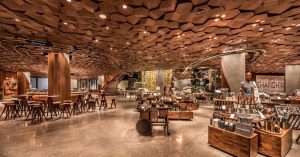 Starbucks Corps views China as passing the United States as its biggest market within the next ten years as it believes the growing number of affluent consumers in the country will offset sluggish growth across the rest of the globe.
Starbucks Corps views China as passing the United States as its biggest market within the next ten years as it believes the growing number of affluent consumers in the country will offset sluggish growth across the rest of the globe.
Ratcheting up focus on China, the coffeehouse chain on Wednesday will open its largest cafe in the world. The 30,000 square foot store in Shanghai is equal to about half a soccer pitch in size and is part of upscale moves that chairman Howard Schultz has championed.
Patrons at the huge new coffeehouse located on the well-known shopping strip West Nanjing Road can watch coffee beans being roasted, use an augmented reality app from Starbucks to interact inside the store and sample high-end coffees.
Starbucks waited three years since it opened its first U.S. based Roastery to finally test the concept in China, where it has over 3,000 stores.
Schultz said on Tuesday at a briefing in Shanghai that it was obvious to the company that the holding power for Starbucks in China will be more significant than the U.S. holding power.
He added that China was on course to be the largest market for the company within the next ten years. China is on the verge of becoming a crucial market for Starbucks. Sales in same-stores were up by 8% in China in the most recent quarter, in comparison to an increase globally of just 2%.
At the same time, revenue from Starbucks Asia-Pacific region represented close to 15% of the revenue for Starbucks during its fiscal year that ended during October. That was up from just 5.5% five years ago.
Starbucks increased its China investment during July, when plans were announced to buy out its joint venture partners. The company agreed to buy the remaining 50% of the joint venture for $1.3 billion, which gave it full ownership of more than 1,300 cafes in the provinces of Jiangsu, Shanghai and Zhejiang.
The company, which says it opens a new store every 15 hours across China, is planning to have more than 5,000 cafes by 2021 on the China mainland.
It is betting that the country’s hunger for luxury, top-end goods transfers to coffee. A regular latte at Starbucks in China is already costlier that fresh coffee in many Shanghai local cafes.
